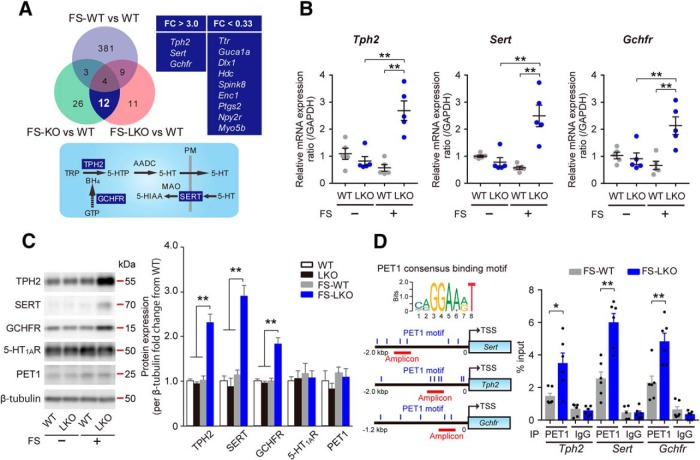Figure 2.
D2LR deficiency upregulates the expression of 5-HT homeostasis-related genes through PET1 activation in the DRN following FS stress. A, Top left, Venn diagram comparing gene expression in the DRN samples from FS-stressed animals from three groups (WT, D2R-KO, and D2LR-KO). FC in expression was compared with non-stressed control WT group (upregulated, FC > 3.0, and downregulated, FC < 0.33); n = 5 mice per group per pool. Top right, Three upregulated and nine downregulated genes overlapping in the FS-stressed D2R-KO and D2LR-KO groups, but not the FS-stressed WT group. Bottom, Serotonergic neurons express proteins related to 5-HT synthesis (TPH2, AADC, and GCHFR), reuptake (SERT), and metabolism (MAO). Tetrahydrobiopterin (BH4), an essential cofactor of TPH2 for the synthesis of 5-HTP, is synthesized de novo from GTP. White letters surrounded by blue squares indicate the shared subsets of upregulated genes shown on the top right. B, RT-qPCR analysis of mRNA levels in mouse DRN lysates. n = 5 mice each. Data were presented as mean ± SEM. **p < 0.01 by two-way ANOVA with Bonferroni's post hoc test. C, Left, Representative immunoblot of mouse DRN lysates probed with the indicated antibodies. Right, Densitometric analysis to determine the FC of indicated protein levels (normalized to β-tubulin) from WT. n = 5 mice each. Data were presented as means ± SEM. **p < 0.01 by one-way ANOVA with Bonferroni's post hoc test. D, Top left, Consensus binding motifs for the mammalian PET1 (Hendricks et al., 1999). Bottom left, PET1 motifs in promoter regions of the indicated genes. The motifs are indicated by blue vertical lines. Right, ChIP-qPCR analysis with a PET1 antibody and a negative control IgG using the indicated amplicons. Results are expressed as percentage input. Data are presented as mean ± SEM. n = 6 mice each. **p < 0.01, *p < 0.05 by two tailed unpaired t test. AADC, Aromatic l-amino acid decarboxylase; MAO, monoamine oxidase; 5-HIAA, 5-hydroxyindoleacetic acid; TRP, tryptophan; PM, plasma membrane; FS-WT, FS-stressed wild-type mice; LKO, D2LR-KO mice; FS-LKO, FS-stressed D2LR-KO mice; KO, D2R-KO mice; FS-KO, FS-stressed D2R-KO mice.

